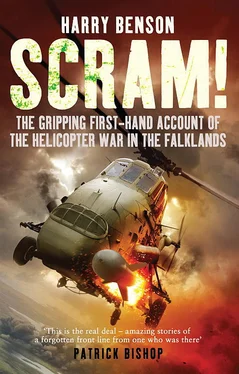As first light was breaking, I circled my finger in the air to the maintainer now standing on the ground just beyond the tip of the rotor blades. He had a last look around and replied with the same hand signal. ‘Engaging rotors,’ I said as I eased the rotor brake off and checked that it was locked off. I then moved the starboard speed select lever slowly forward to accelerate the engine that was now driving the four huge blades. As the blades sped up, the aircraft started to rock slowly from side to side.
As the blades reached flying speed the rocking slowed. With speed select fully forward, the fuel computer would make sure the engine maintained that speed, neither too fast nor too slow. I put the port engine into drive and advanced the lever to the gate. As it reached the gate, it started to help drive the rotors and I saw the starboard fuel flow reduce as the port increased. With a little tweak of both speed select levers, the fuel flows were balanced, showing that the two Rolls-Royce Gnome engines were now taking equal strain.
With the rotors going, I checked that both hydraulic systems were running and the autopilot functioning properly. Neil Cummins checked the winch and load hook. We were ready to roll. I called out my final pre-take-off checks, called for the wheel chocks to be lifted off the grass and put in the back, and prepared for launch with a final adjustment of the friction on my collective lever.
A nearby Wessex announced on the squadron frequency that he was departing from the east side of the hillside. I called him to check my radio was working. The powerful downdraft from his aircraft then buffeted me as he rose up into the dawn air to my right. I called a quick warning that I was departing. ‘X-Ray Lima now lifting from the western side.’ I eased gently up on the collective lever, simultaneously pushing my left foot slowly forward and moving the cyclic stick slightly back and to the left. The faint outline of the disc made by the rotor blades moved upwards and I felt the undercarriage oleos extending as the blades took the strain. With the controls, I felt for the balance needed to keep the aircraft pointing straight and to lift the aircraft vertically. The starboard wheel left the ground followed by the port wheel and finally the tail wheel. A little extra power on the collective and we rose cleanly above the ground.
Normally I would ease off the power and hover at fifteen feet to check the systems were working well. Today, I needed to get clear of the other helicopters that were also starting up. We rose smoothly up into the air and, as I ran my eyes quickly through the cockpit instruments, I eased the cyclic stick forward and increased power a touch more to drop the nose, build up speed and clear the area. A bit of pressure on the left foot corrected the urge to yaw.
As we increased speed, I felt the slight judder of the aerodynamic forces on the blades. I was aware of the other Wessex half a mile in front of me as we passed above the farm buildings of Port San Carlos settlement. I accelerated smoothly up to ninety knots, about a hundred miles per hour, and headed out into San Carlos Bay, flying at fifty feet above the sea. It was hugely exhilarating. I headed into the anti-clockwise pattern around the bay, partly set up to avoid collisions, mostly to identify any intruders.
We had been told to get to HMS Fearless where we would get our first instructions for the day. In front of the dark shadow of the hills on the far side of the bay lay the dozen or so ships. The huge amphibious assault ship Fearless had a junglie Sea King from my sister squadron burning and turning on one of its two helicopter spots. The other assault ship Intrepid , various frigates, a BP fuel tanker and several landing ships were also dotted around the bay. We flew past the frigate HMS Plymouth that had survived a Mirage attack two days earlier. A large black hole in her funnel revealed the target of the bomb that had passed right through it without exploding.
The first breaths of wind were starting to break up the calm water surface. There was patchy cloud at high level above. In the early morning light, the Falklands scenery was stunning. I lowered the collective lever and flared the aircraft to reduce our forward speed, smoothly bringing X-Ray Lima into a hover alongside the flight deck of Fearless .
The flight-deck officer waved me across to the spare landing spot clear of the Sea King. My landing was confident and firm, just as it was supposed to be. ‘Good stuff boss, I’m just disconnecting to get our tasking.’
Cummins then walked out to get our instructions from the flight-deck officer now in front of me.
It was a beautiful day to be at war.
Chapter 3
April Fools: 2 April 1982
THROUGHOUT LATE MARCH, Argentina ignored Britain’s protests about the landings in South Georgia. On the morning of Friday 2 April, a large force of Argentine marines landed on the Falkland Islands near the capital Port Stanley. The British force of sixty-eight Royal Marines of Naval Party 8901 engaged the invaders in a brief firefight, killing one Argentine marine and wounding several others. Overwhelmed by sheer numbers, there was no real choice but to surrender. Falkland Island Governor Rex Hunt and the party of Royal Marines were flown out to Argentina and repatriated to the UK. Many of them would be back within weeks .
The following day, a smaller force of eighty Argentines attempted to secure the British Antarctic Survey base at King Edward Point, near Grytviken on South Georgia, little knowing that the position was occupied by twenty-two Royal Marines dropped there days earlier from HMS Endurance. The Royal Marine detachment put up a spirited surprise defence, crippling an Argentine Puma helicopter and the navy frigate ARA Guerrico, killing several Argentines and wounding many more, at a cost of one Royal Marine wounded. Realising that further action would lead to a pointless bloodbath, Lieutenant Keith Mills RM raised the white flag and negotiated a peaceful surrender. As prisoners, their excellent treatment and repatriation by the Argentines helped set the tone for subsequent prisoner handling on both sides .
We could have let the Falklands go. But the invasion offended British national pride. Most importantly, it offended Prime Minister Margaret Thatcher. Within just a few frantic days, a naval task force was assembled to sail the 8,000 miles and retake the islands. Despite the activity, nobody thought we were serious .
Thursday 1 April 1982. Sub-Lieutenant Paul ‘Hector’ Heathcote sat in his flying overalls in the aircrew room of the RAF station at Aldergrove, near Belfast. Heathcote was one of six pilots, three aircrew and twenty maintainers making up 845 Squadron’s Northern Ireland detachment. The role of the unit was to support Army operations throughout the province. Co-located alongside the resident RAF squadron, each unit provided two Wessex helicopters on permanent call. It was a considerable source of pride that the Royal Navy junglies managed this with just four Wessex helicopters whereas the ‘crabs’, as the RAF are known by the other services, needed twelve. The resulting banter between the two services was usually friendly, but occasionally bubbled over into something more fractious.
The lead story in the newspapers that morning was all about the illegal landing of Argentine scrap merchants on the British protectorate of South Georgia. Heathcote thought it would be amusing to play an April Fools’ joke on his fiancée Linda back in England. What if 845 were deployed down there to deal with them? Later that afternoon he rang her up from the officers’ mess payphone. ‘Sorry darling, we’re all off to the Falklands for three months. We’ve got to go and do something.’
Читать дальше












